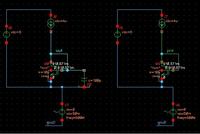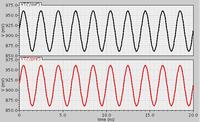fuxinmingming
Member level 1
Hi guys,
When we use current mirror, usually we add bypass capacitance to reduce bias branch's noise.
For example, if I add 500fF bypass capacitance, total noise will be reduced by almost 10 times(noise=kT/C, capacitance increased almost by 10 times).
My question is:
How should I choose this bypass capacitance? Is it semiempirical? Is it 500fF capacitance ok? Or how do I calculate its value?
Regards,
Ming
When we use current mirror, usually we add bypass capacitance to reduce bias branch's noise.
For example, if I add 500fF bypass capacitance, total noise will be reduced by almost 10 times(noise=kT/C, capacitance increased almost by 10 times).
My question is:
How should I choose this bypass capacitance? Is it semiempirical? Is it 500fF capacitance ok? Or how do I calculate its value?
Regards,
Ming


